Civil Services Day 2020 – Lauding the Efforts of Civil Servants During COVID19
The Civil Services Day is celebrated in India every year on April 21st. The day aims at renewing their commitments to public service and excellence in work. It was on this day when Sardar Vallabhbhai Patel, the first Home Minister of Independent India, gave an address to the probationers of Administrative Services Officers at Metcalf House, Delhi in the year 1947. Since then, the day commemorates the special occasion. The first celebration of Civil Services Day was held on April 21, 2006, as Vigyan Bhawan, New Delhi.
Civil servants work tirelessly towards ensuring the smooth functioning of the public administration. Which is why Sardar Patel aptly called the civil servants as the ‘steel frame of India’.
At this time, India is going through extreme crises because of the COVID-19 pandemic. The country has been in lockdown for more than a month, giving rise to a plethora of problems. At this time, the work burden has increased manifold on the administrative system of the country. India’s efforts of fighting against the coronavirus disease have been applauded globally. Major credit for this goes to the bureaucrats of the country.
Let us look at some notable efforts made by the civil servants of India to fight against COVID-19.
CARUNA Initiative
Civil Servants across services including IFS, IPS, IFoS, IRS (IT), IRS (C&E), IRPS, IRTS, IPOS, IA&AS, IDES, ICAS, IIS & IAS have launched a unique CARUNA Initiative to support the government in the right against COVID-19 pandemic. CARUNA stands for ‘Civil Services Association Reach to Support National Disasters, which is an association formed by the above-mentioned services. It is a unique collaborative platform that brings together civil servants, industry leaders, NGO professionals, and IT professionals, among others in the fight against coronavirus pandemic.
Through this initiative, Civil Servants can use their network to collect information and database of migration, essential supplies and medical equipment like masks, ventilators, PPE, etc. The initiative will prove to be highly efficient to map the district level progress of the government’s efforts to curb Coronavirus pandemic, as civil servants are spread across each district in the country. Furthermore, as they are directly working with people and social group, they will also be able to highlight the needs and shortages being felt at the district level.
IRS Officers in Bengaluru Providing Meals to Migrant Workers
While the lockdown is essential at this time in order to contain the spread of the virus, it has taken a major toll on livelihoods of the migrant workers and the fates of their families across the country. These workers who relied on daily wages to secure their daily meals are in a state of helplessness.
Understanding their plight, around 20 IRS officers in Bengaluru have stepped up to aid these vulnerable families. Nishant K, the Joint Commissioner of Income Tax, Bengaluru along with his colleagues have started distributing hot meals to approximately 1,800 migrant workers near Bommasandra. The food is prepared across almost five centres by three private contractors and also includes the Railway Canteen, Karnataka State Chartered Accountant Association canteens. Once cooked and packed, the NGO partners hand the food over to the Bengaluru police who then deliver it to the locations that have been picked.
Duty over Personal Life
A major chunk of the population of the country is currently practising isolation and is working from home, or not working at all. During such a time, there are some champion civil servants who are willing to risk their lives in order to fulfil their duty.
One of them is IAS officer and Greater Visakhapatnam Municipal Corporation Commissioner (GVMC) G Srijana, who returned to work just 22 days after giving birth, cutting short her maternity break. She also brought her nearly 1-month-old baby to work risking the child’s life too to fulfil what she deemed was her duty.
Young #IAS Officers leading #fightagainstcorona.
GVMC Visakhapatnam Commissioner, Ms Gummalla Srijana @GummallaSrijana
joined back on duty with one month old baby without maternity leave to serve the City.#CoronaWarriorshttps://t.co/DyP3s0uU2z pic.twitter.com/2HlpvZU9pC— IAS Association (@IASassociation) April 11, 2020
Another officer who gave utmost importance to his duty is IAS officer and Odisha state health secretary, Nikunja Dhal who returned to duty within 24 hours of his father’s death. Considering the fact that the state is already on high alert over the spread of coronavirus, Dhal a 1993-batch IAS officer, who is a native of Jajpur district was back to work on Tuesday after losing his father on Monday.
Leading from the front. Nikunja Dhal IAS, Pr Secy Health, Govt of Odisha showed exemplary courage when he was back in his office combating the epidemic Coronavirus within 24 hours of his father’s death. #Rolemodels #IndiaFightsCorona@PMOIndia @mygovindiahttps://t.co/BTPzseQA7o
— IAS Association (@IASassociation) March 17, 2020
Applauding the efforts by the civil servants of the country, President Ram Nath Kovind and Prime Minister Narendra Modi took to twitter congratulating the bureaucrats for tackling the COVID-19 outbreak with such great efficiency.
Today, on Civil Services Day I convey greetings to all Civil Servants and their families.
I appreciate their efforts in ensuring India successfully defeats COVID-19. They are working round the clock, assisting those in need and ensuring everyone is healthy.
— Narendra Modi (@narendramodi) April 21, 2020
In the present times too, the steel frame of our country, the civil service, has shown its strength and resolve in handling COVID-19 situation, with sensitivity and professionalism. Confident that our civil services will continue to serve in the best traditions of public service.
— President of India (@rashtrapatibhvn) April 21, 2020
HDFC Bank CSR and Sustainability Impacting 5 Crore Lives in India
Much before corporate social responsibility (CSR) contributions were made mandatory by the Companies Act of 2013, HDFC Bank was following board-approved targets and contributing to social causes. HDFC Bank CSR spend was INR 443.8 crores during the year ending 31 March, 2019, bettering the FY18 performance by 20%, according to the company’s integrated Annual Report.
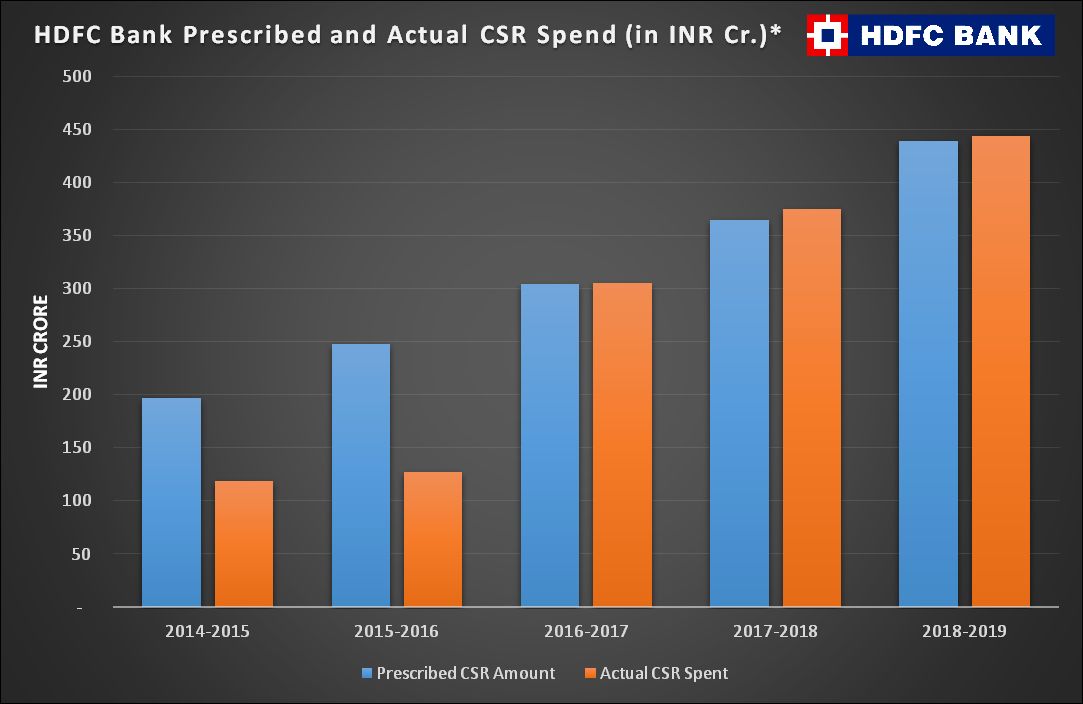
With a commitment of INR 150 crores to the PM-CARES fund, the HDFC Group also joined the fight against COVID-19. HDFC Ltd Chairman Deepak Parekh lauded the efforts of state governments and Centre and said the amount was to show its support to the battle against the deadly virus.
The Housing Development Finance Corporation Limited (HDFC Bank Ltd) commenced its operations as a scheduled commercial bank in January 1995 and is headquartered in Mumbai. It is currently India’s largest private sector lender.
The bank has a diversified network of business operations, which are split into domestic (India) and international operations. The banking services cover Commercial Banking, Investment Banking, Transactional Banking spread over wholesale and retail segments and treasury operations.
Watch a synopsis of HDFC Bank’s sustainability report in the video:
1. Parivartan – HDFC Bank CSR initiative
HDFC Bank Corporate Social Responsibility is implemented under the aegis of ‘Parivartan’ (the umbrella brand for all its social initiatives). HDFC Parivartan aims to bring about a transformation in the communities in which the Bank operates through initiatives in the sectors of Education, Skill training and Livelihood Enhancement, Health Care, Environmental Sustainability and Rural Development.
The CSR Policy (approved by the Board) is driven by the vision of ‘Creating Sustainable Communities’. The company’s CSR policy and programmes are aligned to comply with the requirements of Section 135 of the Companies Act, 2013 and are monitored by a Board-level committee.
2. CSR Policy
According to HDFC Bank CSR policy, its CSR mission is to contribute to the social and economic development of the community. It seeks to mainstream economically, physically and socially challenged groups in society, and to draw them into the cycle of growth, development and empowerment.
At the core of this mission are the Sustainable Livelihood Initiatives (SLI) that reach out to marginalized communities. The company’s corporate sustainability strategy is to integrate its activities in community development, social responsibility and environmental stewardship in such a way that encourages each business unit / function to include these considerations into its operations.
2.1. CSR Committee
In compliance with the guidelines of the Ministry of Corporate Affairs, the company has constituted a Board-level CSR Committee to govern the implementation of the CSR policy. The HDFC Bank CSR committee monitors the progress of CSR projects on a periodic basis. The HDFC Bank Corporate Social Responsibility committee comprises:
1) Mr. Umesh Chandra Sarangi, Chairman (Independent Director)
2) Mr. Aditya Puri
3) Mr. Malay Patel (Independent Director)
4) Mr. Sanjiv Sachar (Additional Independent Director)
2.2. HDFC Bank CSR Team
A dedicated CSR team drives all the CSR programmes with the guidance of senior functionaries, in particular, the Managing Director/ Deputy Managing Director. The CSR Committee and CSR team are entrusted with ensuring that the CSR policy is embedded across the company’s operations. The CSR Department assists in implementation and monitoring of the CSR projects, under the hands-on supervision of Ms. Ashima Bhat, Group Head – CSR; and Ms. Nusrat Pathan, Head – CSR.
Read our full interview with Ms. Ashima Bhat here.
2.3 Implementation of CSR Projects
Ground zero implementation of CSR projects requires the involvement of bank employees and departments in branches across India. The HDFC Bank CSR Department works with more than 80 implementing agencies like NGOs, Trusts, Societies, and also collaborates with other corporates. Some of the partners include NGO FUEL, Aga Khan Rural Support Programme and Aroh Foundation. Implementation partners (with no less than 3 years of experience) undergo strict screening based on the company’s internal screening criteria to ascertain their ability to execute CSR projects.
The CSR Department has the responsibility of monitoring approved projects and funds disbursals for such projects. Monitoring mechanisms include visits, meetings and progress/status reporting by the project teams. The Bank’s CSR activities are reviewed by the CSR Committee. Major CSR projects and achievements are highlighted in the Annual Report.
3. CSR Strategy
CSR in HDFC Bank aspires to create significant and sustainable societal value through its social initiatives to embrace the most disadvantaged sections of society, by empowering millions of people to be self-reliant and contribute to India’s growth. The firm has identified SDGs that align best with its material topics.
The bank believes that national development happens when its communities are empowered to attain sustainable livelihood. In this regard, the Bank, under its social umbrella of ‘Parivartan’ is reaching out to communities to make them self-sufficient and empowered. In FY 2018-19, the HDFC Bank Corporate Social Responsibility spending was INR 443.8 crores. It reached out to more than 5.4 crore beneficiaries in the process.
Find out more about Parivartan in this video:
The progress of any country begins when its communities are empowered to attain sustainable means of livelihood. As a step towards progress, HDFC Bank Parivartan is reaching out to communities to help them shift from a vicious cycle of poverty to a pattern of growth and empowerment.
Social impact in 2019
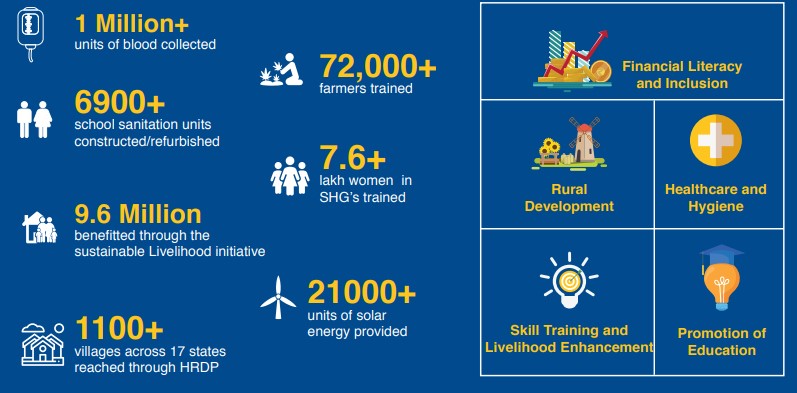
4. Rural Development
I witnessed the firm’s commitment to rural development when I visited two villages in Bihar where the HRDP programme is underway. The CSR team is teaching small farmers organic farming practices, installing solar-powered water pumps, digitising schools and coming up with customised solutions to each neighbourhood’s concerns, which got the whole community proactively involved in the bettering the village.
Holistic Rural Development Programme (HRDP) is the company’s flagship project within Parivartan. It was developed with the belief that Rural Development is central and significant to the nation’s economic development. The rural population is predominantly engaged in agriculture and completely dependent on rainfed irrigation. The programme identifies and addresses the critical needs of each village adopted as part of the programme. There are multiple interventions designed in consultation with the village community and other stakeholders.
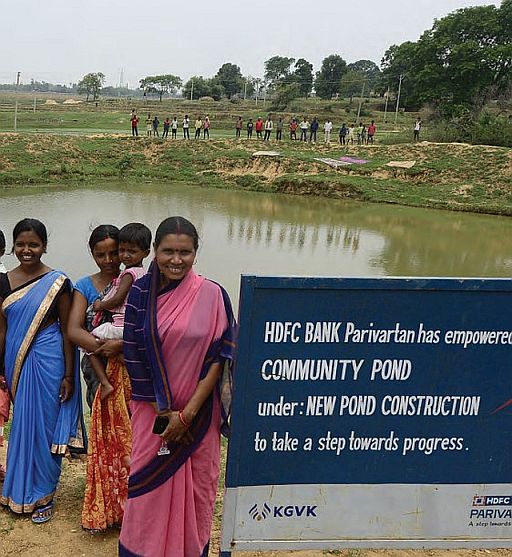
These initiatives are in line with the Adarsh Gaon Abhiyan of the Government of India and the UN SDGs. The critical needs of the chosen villages are first identified and addressed in consultation with the village community and other stakeholders. The initiatives are designed on the basis of their needs and openness. All programmes are continuously monitored and assessed for performance and inconsistencies if any, in terms of funds or execution is flagged off.
4.1. HRDP’s various initiatives are in the following areas:
* Improving educational infrastructure
* Promoting quality education
* Healthcare through health camps and awareness sessions
* Construction of individual household sanitation units
* Natural resources management including micro-watershed management, rain water irrigation, soil and water conservation
* Access to water for drinking and irrigation
* Educating people on renewable energy sources like solar, biogas and biomass
* Promoting financial literacy, job-oriented youth training, creating alternate sources of livelihood such as livestock management and entrepreneurship activities like embroidery, knitting, masala making, toy manufacturing etc.
4.2. Parivartan transforms 5 villages in Madhya Pradesh
The Holistic Rural Development Programme (HRDP) was successfully completed in 5 villages in Mandla district of Madhya Pradesh last year. Thanks to this initiative, 824 households now have access to potable water for drinking and farming as well as training in new and improved agriculture practices.
To address community needs in a sustainable and effective manner in all its HRDP projects, HDFC Bank corporate social responsibility team has created long-term solutions in partnership with an NGO and the local community. The beneficiaries of this project included small farmers, youth, landless labourers, children and women.
The project began on 1st September 2015 and has helped transform Ahmadpur, Surajpura, Thonda, Salhedanda and Pondi villages of Mandla district in Madhya Pradesh. More than 3,500 villagers who were mostly dependent on agriculture and associated seasonal labour as their primary source of income, have now found alternate means of sustenance as a result of the programme.
4.3. Drought mitigation in Maharashtra
In November 2018, Govt. of Maharashtra declared some pockets of the state to be drought affected areas. Stepping up to the opportunity, the bank in partnership with an NGO initiated a Drought Mitigation and Awareness Drive to be implemented in chosen project villages as well as adjacent villages. This included a gamut of activities such as vulnerability mapping, awareness creation, water management, preventive measures for water-borne diseases and creating livelihood opportunities.
Water budgeting was done in 65 villages sensitizing more than 11,000 villagers. To enable groundwater recharge, a total of 87 soil and water conservation structures were created. Activities included nallah (drain) widening and deepening, constructing earthen dams, check dams, loose bouldering structures.
To address the acute issue of water scarcity, water storage tanks were arranged at various locations. Moreover, existing hand-pumps water distribution channels were repaired to prevent water wastage through transportation loss and evaporation. Awareness sessions on water purification methods to prevent water borne diseases were also conducted.
Water scarcity leads to migration and issues like family and social disorganization. In order to provide for better job and self-employment opportunities for the youth, the Bank conducted skill development programme in the villages. Through this, more than 120 youth were mobilized and approximately 40 were enrolled for various courses such as hospitality, automobile, welding, masonry, beautician etc.
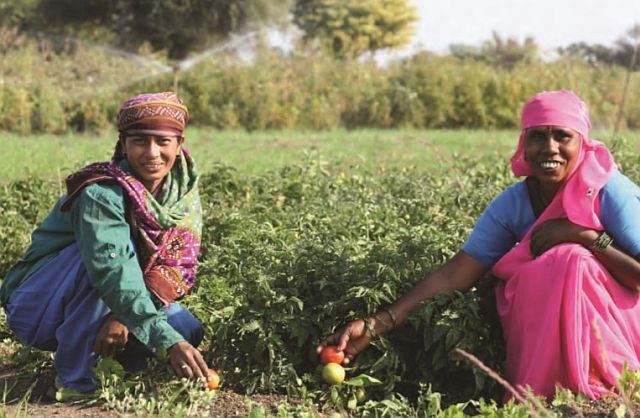
As part of the Green Ethos Movement’ launched in June 2018, over 48,000 trees were planted through community mobilisation. One of these project villages Anjanpur from Ahmednagar districts is also becoming a model village for afforestation. The Bank partnered with two different NGOs for projects in Jalgaon and Yevatmal districts of Maharashtra. Both the projects were designed to address water issues in areas chronically affected by drought. Interventions under these projects have increased water storage capacities of rivers, dams, wells and ponds.
Moreover, the ground water table level has also increased as a result of bore-well recharge. This has also increased the area under irrigation and cultivation. For our work in these villages, the Bank received the ‘Smart Gram Award’ and the ‘Sant Gadgebaba Gram Swachhata Award’ from the Government of Maharashtra.
5. Skills Training and Livelihood Enhancement
Skill Training and Livelihood Enhancement programme provides training and imparts income generating skills, primarily in agriculture and allied areas such as dairy and poultry. This is focused on people in rural areas, especially young women and youth. This programme aims to skill individuals, helping them to find local jobs thereby curbing migration.
The programme entails:
* Various tailor-made skill and competency building programmes such as job oriented training and placement
* Capacity building and communication skills
* Upskilling for agricultural and allied practices
* Promoting entrepreneurial activities
* Agriculture techniques and livestock management
The nationwide programme has benefited over 1 lakh individuals (excluding those trained under the Sustainable Livelihood Initiative or SLI). As a part of the programme, more than 40,000 youth have received placement- linked skill development training. The company has provided both on-farm training to upskill farmers as well as placement linked training. The Bank’s Training Centre in Bhubaneswar provides training to youth and women in hospitality, tourism, telecom, retail and health care. Over 1900 youth were provided job skilled training and exposure providing them access to approx. 100 companies and institutions in Odisha.
5.1. Sustainable Livelihood Initiative (SLI)
The Sustainable Livelihood Initiative (SLI) is aligned with SDG 6 (Gender Equality and women empowerment). The Bank believes that empowering a single woman can empower an entire family. The Bank guides women from the communities to form Self Help Groups (SHGs) or Joint Liability Groups (JLGs). These groups are then trained on occupational skills, financial literacy, credit counselling and livelihood finance in addition to providing market linkages.
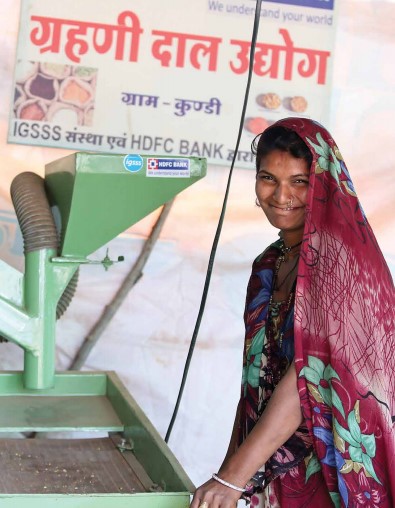
Under SLI, the Bank provides both Financial & Non-Financial services. Financial Products/ Services including Basic Savings Bank Deposit Account (BSBDA) which is a “Zero Balance Account”, Recurring and Fixed Deposits and Insurances are provided to SHG/JLG groups and their members. Non-Financial services include Credit Counselling, and encouraging women to take up entrepreneurship activities.
5.1.a) Case Study: Career Counselling & Skill Training Centre, Bhubaneswar
Due to lack of job-ready skills and career guidance, ambitious and hardworking young individuals like Anjali, Damini, and Saifur could not fulfill their dreams of securing a job and becoming financially independent. Their lives changed when they enrolled at the Career Counselling and Skills Training Centre and acquired the skills to become job-ready, along with 2000 women like them. After successfully completing the three-month Skills Training programme in sectors ranging from telecom, healthcare, retail, tourism & hospitality and BFSI, they have now realized their dream. The youth from Bhubaneswar have been offered employment at leading organizations across the city in their area of specialization.
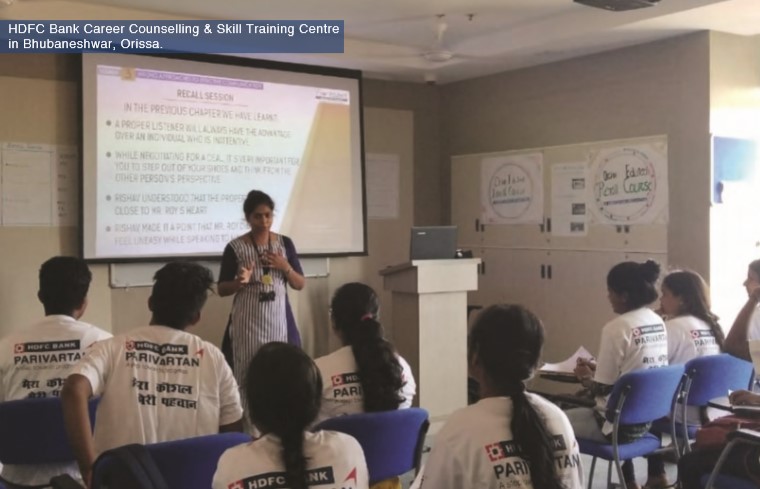
In addition to the skills training, the Bank also provided career counselling to over 8,000 students from schools in and around Bhubaneswar to help them pursue appropriate career opportunities. Besides career counselling, the training sessions comprised of on-campus theory and training, industry visits, meets with industry professionals and on-field internships. Participants were provided with personalized career assessment, career toll-free hotline, career guidance and booklets, SMS alerts, and access to HDFC Parivartan job fairs.
5.1.b) Employment opportunities for 3,000 youth in Nagpur
In FY 2018-19, HDFC launched a Career Counselling and Skills Training Centre for youth in Nagpur, to train them on skills necessary to be job ready. Young women from over 180 villages in and around Nagpur joined the first batch of students at the training centre. On successful completion of the nine-month course, they received certificates from the National Skills Development Corporation (NSDC), making them eligible for jobs in Retail, Telecom, and Tourism & Hospitality.
In addition to the skills training, the Bank has also provided career counselling to over 13,000 students across 65 schools in and around Nagpur to help them pursue appropriate career opportunities. The youth were not only counselled on career opportunities but also given personalized career assessment, career toll-free hotline, career guidance booklet, HDFC Parivartan scholarship booklet and access to job fairs. This programme helps the Bank contribute to SDG 1 – No Poverty and SDG 8 – Decent Work and Economic Growth.
6. Education
Education is the key for developing the economy and transforming an individual’s life. Hence, Parivartan puts focus on inclusive and quality education for all. The Bank strives to promote a conducive learning environment in schools. The Bank’s efforts in the area of education include teacher training, HDFC Bank CSR Parivartan scholarships and career guidance. It also includes provision of infrastructure support, such as building toilets in schools and improving classrooms.
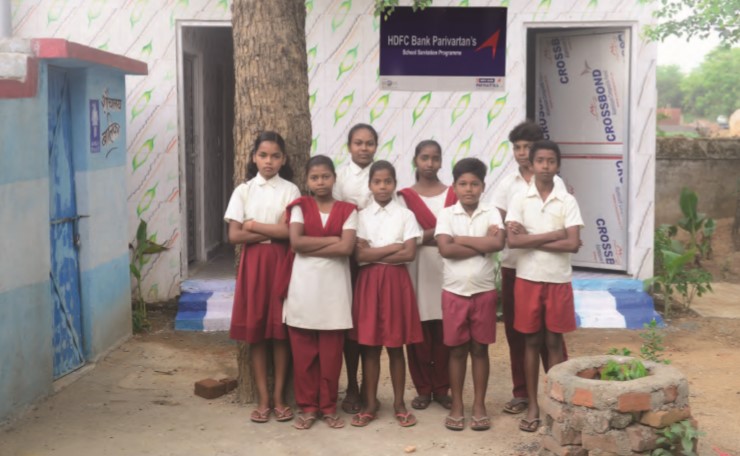
Teacher training provides teachers with alternative teaching pedagogy, improves their soft skills and promotes innovation. The programmes also focus on providing quality education through remedial classes, learning camps, special scholarships etc. This programme is in line with the Sarva Shiksha Abhiyan of the Government of India and SDG 4 (Promoting Quality Education). Navachar Pustika (Innovations Handbook), is a compilation of innovative teaching ideas contributed by teachers themselves. These zero cost, high impact ideas are part of HDFC Bank’s ‘Teaching-the-Teacher’ (3T) programme under #Parivartan. The 3T programme is run in partnership with Sri Aurobindo Society.
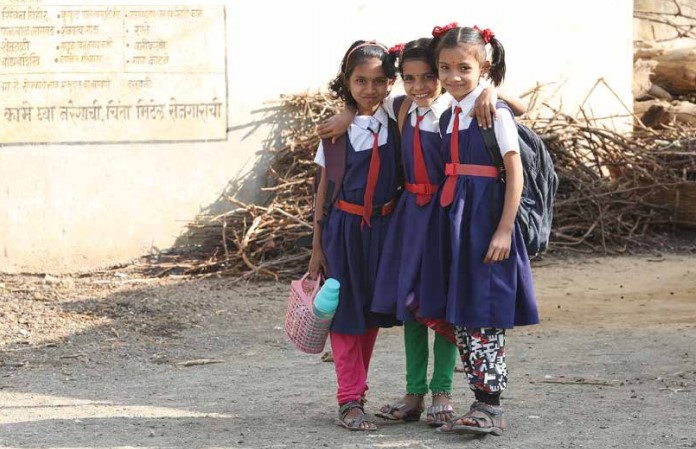
Three flagship programmes under the theme of Education are:
* Zero Investment Innovations for Education Initiatives (ZIIEI)
* Project Disha
* Educational Crisis Scholarship Support (ECSS)
6.1. ZIIEI (Zero Investment Innovations for Education Initiatives)
ZIIEI or Zero Investment Innovations for Education Initiatives seeks to transform education in government schools across India. It is committed to improving the skills of teachers, which in turn, benefits the students.
ZIIEI aims to find ‘the scattered, isolated and unrecognized, but effective solutions’ created by teachers at grassroots and systematically scales them up to millions of schools through the ‘Navachar Pustika’. Along with this transformational journey, the concept of ‘Innovative Pathshaala’ was also introduced, where each chapter of the state curriculum is mapped to innovative ideas that could be used to engage and teach students. A group of teachers have suggested moving away from traditional ‘Chalk and Talk’ technique of teaching to using Dramatization, Puppetry to arouse curiosity among students. This enables better understanding of the topics instead of simply relying on rote.
6.2. Project Disha
Project Disha is yet another initiative that has helped achieve higher levels in numeracy, reading and science in the remote and rural areas of India. Project Disha was initiated in 2016 and is currently spread across four states in India; namely Chhattisgarh, Maharashtra, Madhya Pradesh and Rajasthan. It works with the children in government schools. The project has been able to provide quality education to about 18,000 children.
6.3. Educational Crisis Scholarship Support (ECSS)
HDFC Bank CSR under its ECSS programme, educates children from economically and socially disadvantaged groups who are most at risk of dropping out of school due to sudden financial crisis. The ECSS programme covers students in middle school, high school, as well as scholars pursuing undergraduate and postgraduate education. ECSS Parivartan scholarships help students navigate difficult situations without affecting their education.
7. Healthcare and Sanitation
In line with Government of India’s National Health Mission, Swachh Bharat Abhiyan and the SDGs, HDFC Bank Ltd CSR is geared to work towards fostering behavioural change to improve the Health and Hygiene in India. Since the values of cleanliness and hygiene are best inculcated in childhood, awareness programmes on healthcare and hygiene are conducted in schools. The programme focusses on schools as well as communities.
Core programmes in health and sanitation:
* Community-led sanitation campaigns that promote hygienic conditions in rural areas through appropriate wastewater and sewage disposal
* Construction of toilets
* Provision of clean drinking water
* Health camps, nutrition programs, and vaccination drives
* Conducting blood donation drives
7.1 Change for Childhood Cancer in Tamil Nadu
HDFC Life joined hands with Cankids Kidscan in the year 2016, to support the cause of childhood cancer in Tamil Nadu. Families belonging to the economically challenged segment of the society and incapable of affording cancer treatment for their children, have been the target beneficiaries under this CSR initiative.
HDFC Life helped set up two dedicated cancer wards – Cankids Hospital Support Units (CHSUs) in the Institute of Child Health and Hospital for Children at Chennai. These dedicated wards provide cancer treatment support to children in the form of medical, psycho-social and nutritional support thereby aiding the children and their families cope with the disease.
The overarching aim of setting up these dedicated wards is to ensure that the children are not deprived of appropriate treatment for the disease, thereby reducing the treatment abandonment rate.
In addition to the wards, a full-fledged accommodation facility – Home Away from Home, has also been set up which provides complete accommodation support to the families of the children undergoing cancer treatment. This intervention has aided more than 2,500 underprivileged children till date and counting.
8. Financial Literacy
In India, millions of people are excluded from the formal economy and are thus deprived of its benefits. HDFC Bank CSR strives to cater to the unbanked and under-banked population in rural, semi-urban and urban India.
8.1. Milk-to-Money ATMs
Multi-function Terminals (MFTs) popularised as Milk-to-Money ATMs bring transparency in the milk procurement and payment process. The MFT, like a standard ATM, contains a cash dispenser that facilitates quick access to payments which greatly benefits many dairy farmers. As of last year, the Bank has digitized payments at over 1,000 milk co-operatives spread over 18 states benefiting more than 4 lakh dairy farmers. The Bank facilitates instant realization of payments for over 1 lakh customers.
8.2. Financial literacy for SMEs
The firm has extended its financial literacy programme to the general public as well as SME entrepreneurs. Under this initiative, HDFC Bank conducts financial literacy camps in various states to bring SMEs into the traditional banking fold. Advances to the MSME segment as on March 31st, 2018 stood at INR 89,042.1 Crore while advances to the Micro Enterprises alone stood at INR 40,644.7 Crore. The Emerging Enterprises and Business Banking Groups cater to the Micro Enterprises and SME segments respectively.
8.3. Digital literacy
The campaign ‘Bank Aapki Mutthi Mein’ was the starting of the digital journey of the Bank. Digitization within the Bank has certainly given customers a convenient banking experience while also decreasing the Bank’s carbon footprint by minimizing footfalls and physical transactions at ATMs and Branches. Digital literacy camps are conducted across villages to ensure that the rural population are also capacitated with online banking.
9. Alignment with UN Sustainable Development Goals
Transitioning towards a low carbon economy is the need of the hour. As a responsible business, it has been measuring its greenhouse gas (GHG) emissions since 2010, according to the HDFC Bank sustainability report. Addressing and mitigating environmental concerns also makes business sense as climate change impacts have the potential to not just impact operations but also revenues, by impacting lending and investments.
HDFC Bank has set a goal of 10% reduction in its Scope 1 and 2 emissions intensity by FY 2021-22. The Bank has aligned itself to the SDGs (Sustainable Development Goals set by the United Nations for the year 2030) and works towards integrating them into its business strategy. It is harnessing renewable energy through installed solar panels in its office premises aligns with SDG 7 – Affordable and Clean Energy.
The Bank ensures responsible consumption of natural resources, complying with SDG 11 and 12 – Sustainable Cities and Communities. Initiatives taken by the Bank towards SDG 12 (Responsible Consumption and Production) include efforts to monitor and reduce energy consumption, installing capacitor banks and occupation sensors for reducing electricity consumption and sensor-based faucets in washrooms for water conservation.
10. Environmental Responsibility
The Bank’s environmental policy articulates that the large loans disbursed by the Bank, will first be assessed for environmental and social risks. The projects should comply with the environmental norms of the land and, should have a plan for implementing and monitoring environmental initiatives. In FY 2017-18 there were no fines, non-monetary sanctions or cases brought forward regarding non-compliance with environmental and social laws and regulations against the Bank.
10.1. Energy Management
In FY 2018-19, the energy consumption per employee was 22.6 GJ (energy intensity, the energy taken into account is energy consumed within the organization), 16% less than the previous year. There is a decrease in both the electricity and diesel consumption, this is partly attributed to a change in methodology and emission factors used in the calculation of emissions. HDFC Bank has adopted Energy Efficient Management Systems (EnMS) to improve energy efficiency in its operations and systematically manage energy use.
EnMS and other energy-saving methods were probably the reason for reduction in electricity usage, despite a substantial increase in the number of employees compared to the previous year. The Bank records employee travel/ business commute under scope 3 emissions but does not track/ measure energy equivalent of the same.
10.2. Renewable Energy
HDFC Bank CSR is serious about alignment with SDG 7 (Affordable and Clean Energy). As on 31st March 2019, the Bank had a cumulative installed solar capacity of 135.5 KWP across Jaipur, Pune, Noida and Bhubaneswar. The electricity generated from these solar panels in FY 2018-19 was estimated at 1,62,600 KWh, about 58% more than the previous year, attributed to the addition of a solar plant at Bhubaneswar. The Bank has been using renewable energy to power ATMs in areas with a fluctuating power supply.
10.3. Emissions and Climate Change
The Bank understands the criticality of environmental challenges and the benefits of transitioning towards a low carbon economy. Therefore, in line with SDG 13 which is undisputedly one of the important focus areas today, there is an urgent need to combat climate change. Last year, there was a drop of 11% in absolute combined Scope 1 and Scope 2 emissions because of EnMS and other energy saving initiatives in the through the Bank offices and branches. There was a change in methodology and use of emission factors in the calculation of fuel consumption, contributing to the decrease in emissions.
In order to sensitise its stakeholders on emissions reduction, the company has adopted digital banking channels, energy efficiency initiatives and paper conservation measures. Emissions other than Scope 1, 2 and 3 for example SOx, NOx and SPM are not material to the Bank as it operates in the service sector. Currently the measurement of coolant leaks as part of Scope 1 emissions are not being captured; the process for recording the measurement is in progress and will be reported in the next reporting period. The total amount of distance travelled for the various sectors is determined to calculate the emissions generated from Business Travel.
11. Responsible Lending
HDFC Bank Ltd refrains from funding projects that will prove to have an adverse impact on Environment, Health and Safety (EHS). The bank considers EHS to be an integral part of overall credit risk assessment and monitoring. Every project funded has to pass the Bank’s muster in terms of the EHS risk it entails, potential impact and mitigation measures in place or proposed. All projects which are financed have the clause on not using child, compulsory or forced labour.
The Relationship Manager (RM) has to report compliance with EHS norms in the Credit Assessment Memorandum (CAM) both at the time of initial sanction and during the monitoring process. Such certification is based on information or disclosures provided by the borrower at the time of initial appraisal and during periodic review of the facilities. The relationship manager records outstanding EHS issues (if any), and follows them up with the client.
The bank levies penal interest in case of deviations and, thus, ensures compliance with EHS norms. If there are significant deviations that could affect the viability of the project, HDFC Bank reserves the right to either reduce its exposure or recall the loan. Most significantly, the Bank, as part of its credit policy, requires all projects perceived as carrying high or unusual EHS risk to be approved by a higher authority.
Bottomline
HDFC Bank corporate social responsibility has positively impacted 5 crore lives through #Parivartan. It has collected over 1 million units of blood, constructed (or renovated) 7,000 toilets in school, trained 7.6 lakh women in SHGs (self help groups) and provided 21,000 renewable energy units. Not only is it among the top spenders on CSR in India, it is among the few corporates to adopt an integrated reporting approach.
पालघर – अफवाहें लेती है जान, इसलिए सामाजिक जिम्मेदार बनें
आज के इस सोशल मीडिया के ज़माने में अफवाहें जान लेने लगी है, कई मामले पहले भी देखी गयी है और ये सिलसिला लगातार जारी है, ताज़ा मामला महाराष्ट्र के पालघर का है जहां दो साधुओं समेत एक ड्राइवर की भीड़ द्वारा हत्या कर दी गयी। अब मामला सांप्रदायिक रंग अख्तियार करने लगा है। जाहिर है लापरवाही जरूर हुई है, स्थानीय पुलिस द्वारा, सरकार द्वारा क्योंकि ये मॉब लिंचिंग का कोई पहला केस नहीं है इसके पहले भी मामले हुए है, अखलाख जैसे तमाम उदाहरण समाज में आज भी पनप रहें है। इन सब पर अंकुश जरूर लग जाता जब सरकारें सोशल मीडिया की अफवाहों पर लगाम लगा पाती। सख्त कानून होता, भीड़ समझदार होती। ये समझ पाती कि जो मैसेज, जो कहानी उन्हें बताई जा रही है उसमें क्या सच्चाई है और कितना झूठ।
बहरहाल सरकार, पुलिस और जनता ये तीनों अगर अपनी सामाजिक जिम्मेदारी को बखूबी समझती तो शायद निर्दोष साधुओं की मौत नहीं होती। जाहिर है साधुओं की मौत हुई है तो सम्प्रदाय जरूर जुड़ेगा। मामला गंभीर हो गया है, मामला मीडिया में सुर्खियां बन रही है तो अब जमकर राजनीती भी होगी लेकिन इसमें कोई भी राजनीति नहीं है। एक पालघर का मामला महज एक अफवाह पर आधारित है। एक अफवाह ने ही तीन लोगों की जिंदगियां लील लीं।
दरअसल गुरुवार की शाम दो साधु मुंबई के कांदिवली से ड्राइवर के साथ सूरत के लिए निकले थे, सूरत में इन साधुओं के किसी करीबी का निधन हो गया था उनकी अंतिम संस्कार में शामिल होने के लिए ये मुंबई से सूरत जा रहें थे। पालघर के जिस गांव से होकर गुजर रहे थे वहां अपहरण और चोरी की अफवाह फैली थी, अफवाह थी कि लॉकडाउन की आड़ में अपहरण किया जा रहा है, अफवाह ये भी थी कि अपहरण कर लोगों की किडनी निकाली जा रही है। इसी अफवाह की चपेट में गांव से गुजरने वाले ये तीनों लोग आए। लेकिन ये हत्या पुलिस की मौजूदगी में हुई। पुलिस भीड़ से बचाने के बजाय खुद बचती नज़र आयी। अगर मौके पर मौजूद पुलिसकर्मी कुछ हिम्मत दिखाते तो इन तीन निर्दोषों की जान नहीं जाती।
पालघर मॉब लिंचिंग के मामले में सोमवार को गृहमंत्रालय ने महाराष्ट्र सरकार से रिपोर्ट मांगी है। महाराष्ट्र के सीएम उद्धव ठाकरे से सोमवार को ही गृहमंत्री अमित शाह ने फोन पर बात की। इस बातचीत के बाद ऊद्धव ने कहा कि उन्होंने अमित शाह और उत्तर प्रदेश के मुख्यमंत्री योगी आदित्यनाथ को इस बारे में जानकारी दी है। राज्य सरकार ने इस मामले में कार्रवाई की है। 110 लोगों को रविवार को गिरफ्तार किया गया था, इसमें कुछ नाबालिग भी थे। उद्धव ने कहा कि हमने दो पुलिसवालों को सस्पेंड कर दिया है। उन्होंने यह भी कहा कि पालघर मॉबलिंचिंग में सांप्रदायिक एंगल नहीं है।
3 Often-Missed Opportunities to Build in Harmony With the Environment

By: Nicole Schlabach
Man-made structures should co-exist with their surroundings. Ecosystems thrive because of the interconnected nature of natural systems.
Similarly, architects can harvest rich, free benefits from their surroundings by building in harmony with their environment.
Too often, buildings are constructed by altering the landscape to fit pre-existing needs.
Instead, you should approach your landscape with an open mindset to see how you can leverage sun, rain, and temperature patterns.
If you’re looking to build a commercial building, make sure you don’t miss out on these opportunities.
1. Get Strategic About the Sun’s Rays
While considering the amenities of your new office location, consider the sun as well. It’s a little-known fact that strategic building orientation correlates with energy efficiency.
The ideal structure receives more sunlight (warmth) in the winter and less in the summer. This way, you’ll pay less to heat and cool your building.
According to the US Department of Energy, a passive solar home may cost half as much to heat as a typical one. Cost savings benefits apply to commercial buildings, too.
For background, the sun is positioned in the southern sky in the winter and in the northern sky in the summer.
You’ll want to orient your building so the longest sides face the north and south axis and the shortest sides face the east and west axis.
Source: Nachi.org
After deciding your building’s orientation, choose where to put your windows. Place more windows on the southern side of your structure than the northern side.
The combination of orientation and windows allows your building to exist in harmony with yearly solar patterns. It will receive less solar energy during the summer and more during the winter.
When designing your building, make sure you ask for a solar study. This assessment will reveal exactly how the sun impacts your building throughout the year.
The sun offers free solar warmth — make sure you capitalize on it! Your utility bill and employees will thank you for creating a more comfortable, efficient workplace.
2. Go Beyond Drainage, Rainwater is a Resource
When designing a building, water drainage is an essential concern. However, instead of getting rid of water, have you considered reusing it?
Water, just like the sun, can be a free resource if you’re creative enough to leverage it. Amazingly, up to half of the non-potable water your commercial building uses each day could be swapped with rainwater.
The Edge, named the smartest building in the world by Bloomberg, is a phenomenal example of how to reap pre-existing services offered by a landscape.
It reuses its rainwater for purposes that normally require an external water source.
Water that falls on the roof and balconies is collected into a concrete container behind the parking garage. Then, the stormwater is used to flush toilets and irrigate green terraces and gardens.
Underground, another tank serves as an aquifer thermal energy storage system for The Edge. This means it uses water for the building’s heating and cooling.
The Edge uses innovative techniques. But, everyday office spaces can employ rainwater harvesting, too. Bins can be installed above or below the ground, and they’re typically fed by gutters surrounding the building.
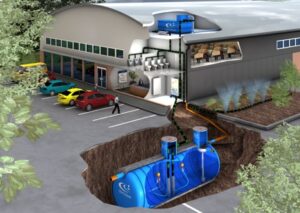
Source: Renewableenergyhub.co.us, Courtesy of Stormsaver Ltd.
According to Rainwater Resources, any commercial building with a large roof and demand for non-drinkable water is a candidate.
Consult the Renewable Energy Hub for the United States to learn more, find a local installer, and compare prices.
3. Greenspace Isn’t Just For Humans — Consider Plants & Animals, Too
Employees who have access to greenspace are more productive. Your greenspace could benefit your local ecosystem too.
If you’re in the market for plants and outdoor structures, you might as well choose ones that will help the local environment thrive.
If you’re in an urban environment, greenspace can provide a valuable refuge for insects and animals.
For example, The Edge put an ecological corridor on its terrace. It holds vegetation that’s friendly to important pollinators. Hive towers featuring tiny holes support local bee populations.
The Edge’s greenspace also features birdhouses and bat boxes in its landscaping for the creatures to nest.
If you’re buying plants, anyway, you should choose native vegetation. Choosing plants that occur naturally in your area will provide benefits to local organisms and require less caretaking.
Be smart about your outdoor space, and you’ll foster mutually beneficial results for the environment and your employees.
Take a Holistic Approach to Your Building’s Design
Since you’re already designing a new building, you might as well take advantage of the existing benefits nature provides.
Orient the building so it benefits from yearly sunlight patterns, and consider harvesting rainwater instead of simply draining it.
Choose to create a building that sustains, rather than degrades, the environment by supporting local organisms in your outdoor space.
Since your building doesn’t exist in a vacuum, your design strategy shouldn’t, either.
 Nicole Schlabach leads real estate and architectural design research efforts for Clutch, a ratings and reviews platform for B2B services and solutions providers.
Nicole Schlabach leads real estate and architectural design research efforts for Clutch, a ratings and reviews platform for B2B services and solutions providers.
To read more articles from Clutch, click here.
Thank you for reading. Please drop a line and help us do better.
Regards,
The CSR Journal Team










